Paris recs requested
Paris recs requested
-
-
-
-
-
-
Post #61 - November 3rd, 2010, 2:35 pmkl1191 wrote:A couple quick questions: Which of the "bistro-style places" was your favorite? And, assuming reservations were required at La Régalade Saint Honoré, were they difficult to obtain?
It'd be a tough call between Joséphine Chez Dumonet and La Régalade Saint Honoré. I'd probably choose La Régalade Saint Honoré 6 times out of 10 because I liked the seasonality and inventiveness of their menu. But if I were in the mood for a more traditional take, I'd choose Joséphine Chez Dumonet in a heartbeat because the execution was virtually flawless. At both places, which are very small, reservations are necessary...at least for dinner. In our case, the concierge at our hotel made them for us but friends of ours were able to get dinner reservations at both places with less than a week's lead time.
=R=By protecting others, you save yourself. If you only think of yourself, you'll only destroy yourself. --Kambei Shimada
Every human interaction is an opportunity for disappointment --RS
There's a horse loose in a hospital --JM
That don't impress me much --Shania Twain
-
-
Post #62 - November 3rd, 2010, 2:40 pmI wanted to add that I've already posted a few pics from both of these meals (and a few others) on the Best Thing You've Eaten [Lately] thread.
=R=By protecting others, you save yourself. If you only think of yourself, you'll only destroy yourself. --Kambei Shimada
Every human interaction is an opportunity for disappointment --RS
There's a horse loose in a hospital --JM
That don't impress me much --Shania Twain
-
-
Post #63 - November 3rd, 2010, 3:30 pmThis month's issue of Saveur has a very good article about Paris bistros. My favorite bistro meal from my last trip consisted of Utah Beach oysters and line caught Dover Sole at L'Ecailler du Bistrot. Both of these items are out of this world and should not be missed.
Open Tuesday through Saturday for lunch and dinner.
Address: 22 Rue Paul Bert, 75011 Paris
Phone: (33) 01 43 72 76 77
If you would like to tackle the worlds largest serving of foie gras or a beautiful steak tartar, I would strongly recommend Chez Dumonnet. Many of the appetizers can be ordered in half portions and for good reason. The duck confit was also very good. I'm not sure exactly why but we had a really great time dining there. It was a place where people seemed to be having a good time and it was kind of infectious.
-
-
Post #64 - November 3rd, 2010, 4:32 pmdeesher wrote:I'm not sure exactly why but we had a really great time dining there. It was a place where people seemed to be having a good time and it was kind of infectious.
This mirrors our experience and in our case, it definitely had a lot to do with chef Jean-Christian Dumonet who, aside from being a meticulous chef, was also quite a compelling character. He worked the room like a general -- not necessarily schmoozing but chatting with guests, policing the staff and orchestrating everything. He commanded the restaurant in an unmistakably effective manner and also had a great sense of humor.
=R=By protecting others, you save yourself. If you only think of yourself, you'll only destroy yourself. --Kambei Shimada
Every human interaction is an opportunity for disappointment --RS
There's a horse loose in a hospital --JM
That don't impress me much --Shania Twain
-
-
Post #65 - November 8th, 2010, 8:48 pmI posted some notes about lunch at Alain Ducasse à l'hôtel Plaza Athenée here. More individual-restaurant reports from out trip to follow.
=R=By protecting others, you save yourself. If you only think of yourself, you'll only destroy yourself. --Kambei Shimada
Every human interaction is an opportunity for disappointment --RS
There's a horse loose in a hospital --JM
That don't impress me much --Shania Twain
-
-
Post #66 - November 8th, 2010, 9:28 pmkl1191 wrote:ronnie_suburban wrote:I'm recently back from 10 days in Paris and had some pretty great food while I was there. I'm going to start my report with a list of places I went that I'd definitely recommend -- along with some brief classification notes -- and follow up over the next couple of weeks with detailed posts about individual places.
Looking forward to it...we're heading back to Paris for a week over Thanksgiving, so it will be good to get some extremely recent reviews.
A couple quick questions: Which of the "bistro-style places" was your favorite? And, assuming reservations were required at La Régalade Saint Honoré, were they difficult to obtain?
I know this wasn't intended for me but as my wife and I recall our summer in Paris a few places just keep coming to mind. In this category, I would echo the praise for Chez Dumonet and would add the following:
-Bistrot Paul Bert - seemed to be every Parisien's "favorite" bistro and for good reason.
-A La Biche au Bois - not quite "off the beaten path" but far enough so that you typically don't see "too" many tourists - nice neighborhood though and not difficult to find nor get to. Fixed menu at about 29 euro with a very generous cheese assortment. If you'll be there in Nov, there's a chance that they'll be offering more game dishes - their signature.
-Café de Musees - Open on Sunday and less tourists than you'd think, especially in this neighborhood. I had one the best things I ate this year there - pork shoulder in garlic sauce. If it's on the menu, get it.
Oh yeah, always get reservations. All of these places speak a little English and were very nice to us (non French speakers). Also, upthread, I think I mention Lebovitz' blog and the parisbymouth site. Recommend both highly.
I was there for June and July this year - not exactly "extremely" recent but if you have any questions, feel free to PM me. Have fun.
-Russ"It's not that I'm on commission, it's just I've sifted through a lot of stuff and it's not worth filling up on the bland when the extraordinary is within equidistant tasting distance." - David Lebovitz
-
-
Post #67 - November 8th, 2010, 9:58 pmtyrus wrote:kl1191 wrote:ronnie_suburban wrote:I'm recently back from 10 days in Paris and had some pretty great food while I was there. I'm going to start my report with a list of places I went that I'd definitely recommend -- along with some brief classification notes -- and follow up over the next couple of weeks with detailed posts about individual places.
Looking forward to it...we're heading back to Paris for a week over Thanksgiving, so it will be good to get some extremely recent reviews.
A couple quick questions: Which of the "bistro-style places" was your favorite? And, assuming reservations were required at La Régalade Saint Honoré, were they difficult to obtain?
I know this wasn't intended for me but as my wife and I recall our summer in Paris a few places just keep coming to mind. In this category, I would echo the praise for Chez Dumonet and would add the following:
-Bistrot Paul Bert - seemed to be every Parisien's "favorite" bistro and for good reason.
-A La Biche au Bois - not quite "off the beaten path" but far enough so that you typically don't see "too" many tourists - nice neighborhood though and not difficult to find nor get to. Fixed menu at about 29 euro with a very generous cheese assortment. If you'll be there in Nov, there's a chance that they'll be offering more game dishes - their signature.
-Café de Musees - Open on Sunday and less tourists than you'd think, especially in this neighborhood. I had one the best things I ate this year there - pork shoulder in garlic sauce. If it's on the menu, get it.
Oh yeah, always get reservations. All of these places speak a little English and were very nice to us (non French speakers). Also, upthread, I think I mention Lebovitz' blog and the parisbymouth site. Recommend both highly.
I was there for June and July this year - not exactly "extremely" recent but if you have any questions, feel free to PM me. Have fun.
-Russ
Thank you, Russ & Ronnie.
I've heard a lot of good things about Paul Bert, and if we can fit it in we certainly will. We found Café de Musees a visit or two ago thanks to the Hungry for Paris book. I still carry their business card with me and suggest it to folks all of the time...the last time we were there was probably over a year ago at this point, but I had a fantastic blood sausage terrine with green chartreuse that I can still close my eyes and taste to this day. It may get a stop if we get over to the Picasso Museum this time around, or maybe for Sunday dinner, as our other options are quite slim.
We have the great fortune that my best friend's sister lives in Paris and has offered to make all of our reservations for us, so my wife is off the hook (her French is a million times better than mine, but she hates speaking on the phone). When I told our friend that we wanted to go to La Régalade Saint Honoré, she asked if she and her husband could join us...it's their favorite place right now, so I'm very excited for that. I think Joséphine Chez Dumonet will also be a must.
A few random questions:
Is it worth trying to cram oneself into L'Avant Comptoir?
Le Chateaubriand, is it Schwa Paris or a fashion show that also serves food?
Planning to check out the cocktail scene, I've heard the latest from the Experimental/Curio group is Prescription Cocktail Club...if anyone has any good info on any of the three, I'd appreciate it.
Not to get too off-topic, but anyone have any recommendations for the Loire Valley? (Feel free to PM.)
Thanks.
-
-
Post #68 - November 8th, 2010, 10:56 pmA simply lovely place to stay in the Loire is Chateau du Pray, near Amboise. The accomodations are superb, the house kitchen is excellent, and there's plenty of other things to see and do in the neighborhood.
GeoSooo, you like wine and are looking for something good to read? Maybe *this* will do the trick!
-
-
Post #69 - November 9th, 2010, 6:45 pmI posted some notes and pictures from our dinner at La Régalade Saint Honoré here.
=R=By protecting others, you save yourself. If you only think of yourself, you'll only destroy yourself. --Kambei Shimada
Every human interaction is an opportunity for disappointment --RS
There's a horse loose in a hospital --JM
That don't impress me much --Shania Twain
-
-
Post #70 - November 9th, 2010, 9:45 pmI posted some notes and pictures from our meal at Chez Dumonet, Restaurant Josephine here.
=R=By protecting others, you save yourself. If you only think of yourself, you'll only destroy yourself. --Kambei Shimada
Every human interaction is an opportunity for disappointment --RS
There's a horse loose in a hospital --JM
That don't impress me much --Shania Twain
-
-
Post #71 - November 12th, 2010, 1:40 pmI posted some notes and pictures from our meal at Restaurant La Fontaine de Mars here.
=R=By protecting others, you save yourself. If you only think of yourself, you'll only destroy yourself. --Kambei Shimada
Every human interaction is an opportunity for disappointment --RS
There's a horse loose in a hospital --JM
That don't impress me much --Shania Twain
-
-
Post #72 - November 13th, 2010, 3:06 pmI posted some notes and pictures from our meal at La Tour de Montlhéry's Chez Denise here.
=R=By protecting others, you save yourself. If you only think of yourself, you'll only destroy yourself. --Kambei Shimada
Every human interaction is an opportunity for disappointment --RS
There's a horse loose in a hospital --JM
That don't impress me much --Shania Twain
-
-
Post #73 - September 17th, 2012, 9:14 pmOur favorite meal in Paris.
Rue Cler Shopping
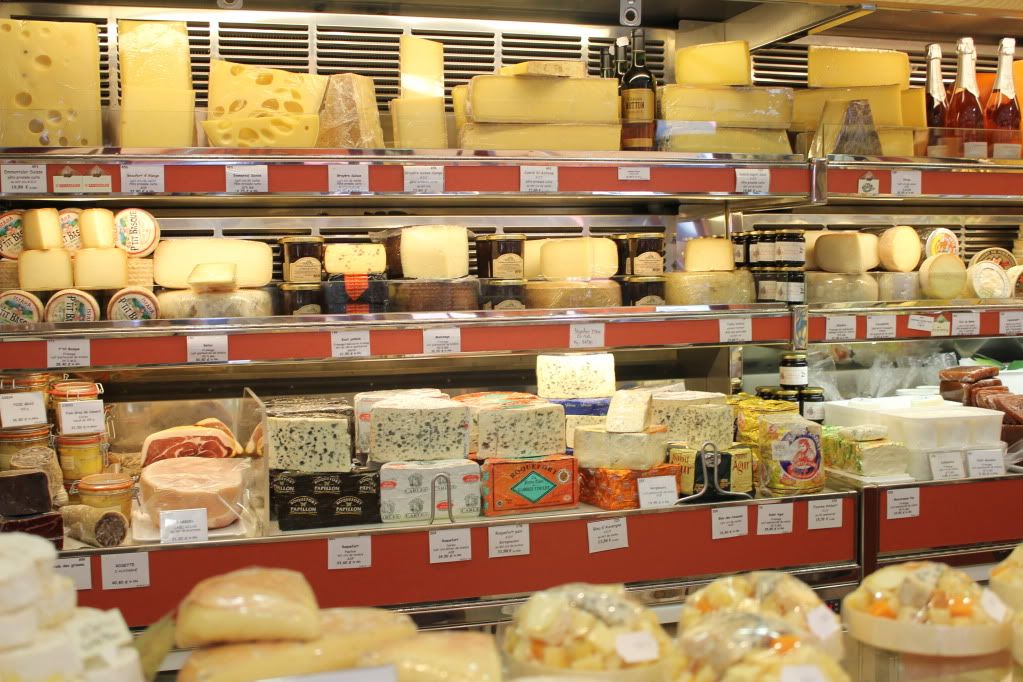


Setting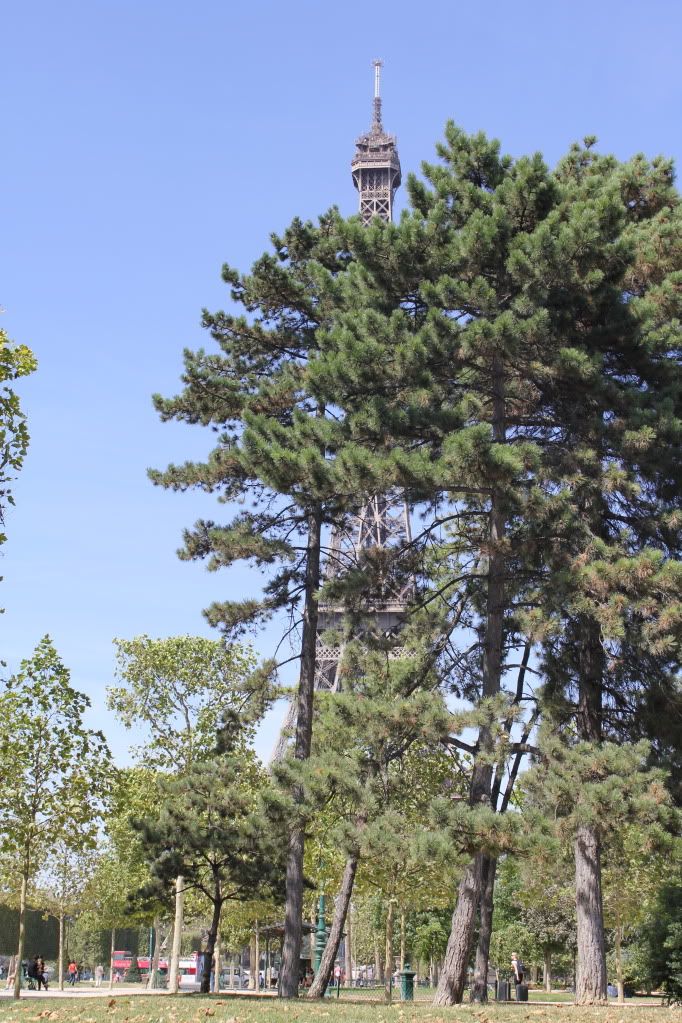
Meal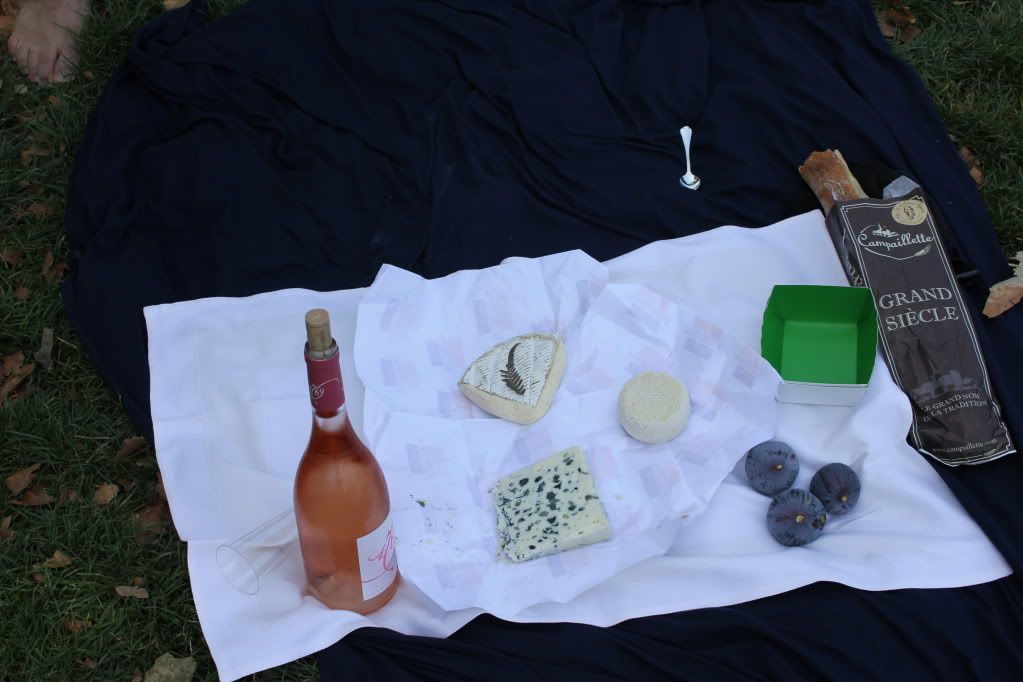
Other highlights:
Chez Dumonet Josephine
Le Chateaubriand
One ore two more to follow in this thread.
-
-
Post #74 - September 17th, 2012, 9:40 pmAwesome stuff, jfibro. I'm heading back over next month, so please keep 'em coming.
Thanks,
=R=By protecting others, you save yourself. If you only think of yourself, you'll only destroy yourself. --Kambei Shimada
Every human interaction is an opportunity for disappointment --RS
There's a horse loose in a hospital --JM
That don't impress me much --Shania Twain
-
-
Post #75 - September 18th, 2012, 7:29 pmWe had several of our Paris dinners booked through our concierge before we left. However, it was the end of August, so we had some closings to deal with, and we also wanted to have some flexibility. Cafe Constant was on my radar, was very close to our hotel (between it and the Eiffel Tower), and came highly recommended from the concierge as well. It ended up being a perfect last minute decision, and I think my favorite dinner of the trip.
Cafe Constant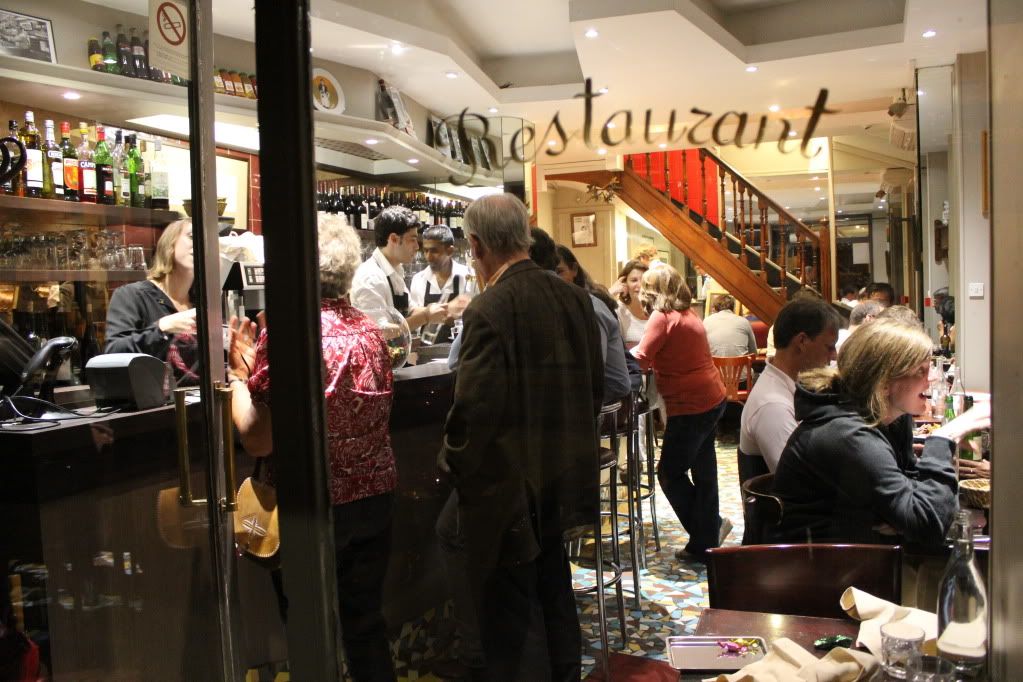
No reservations taken. We walked up and waited about 30 minutes.
Oyster & Salmon Tartare with Ginger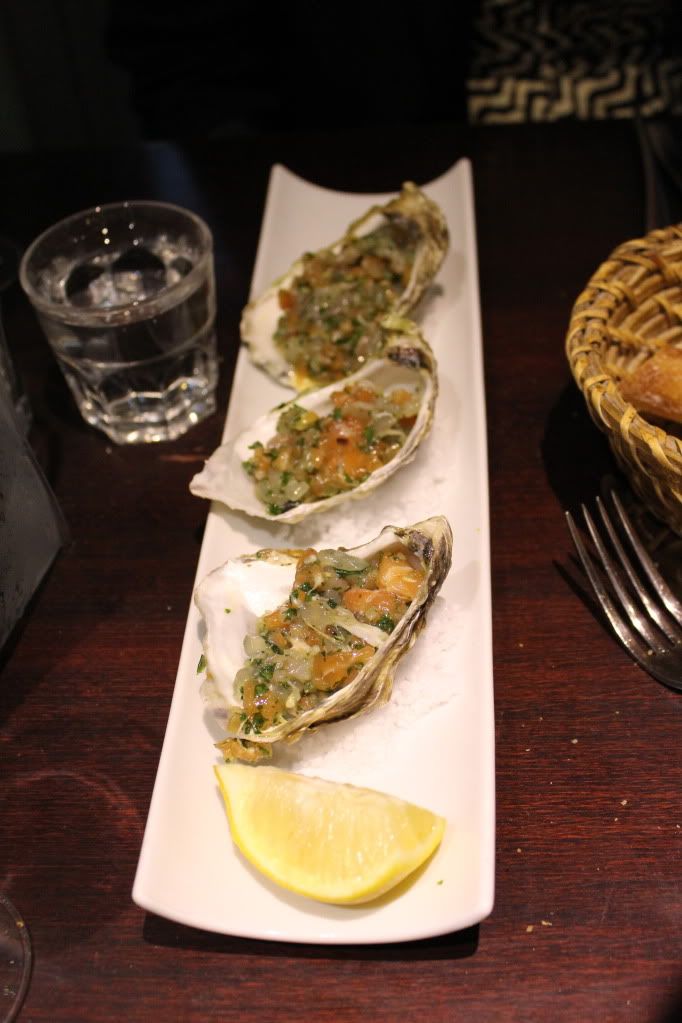
I loved this dish. Fresh, clean, crisp flavors. Could clearly taste both the salmon and oyster. I wanted to request several more orders and actually debated coming back on another night just to get some.
Beef Bourguignon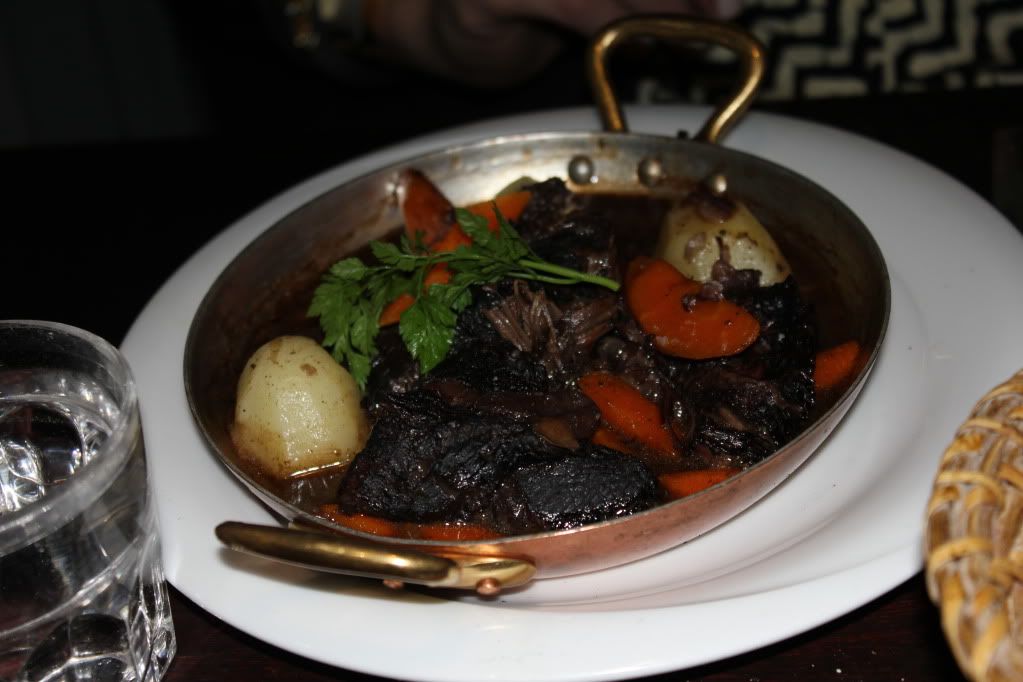
Excellent rendition. I only had a bite, but thought it as good as Chez Josephine's.
Tete de Veau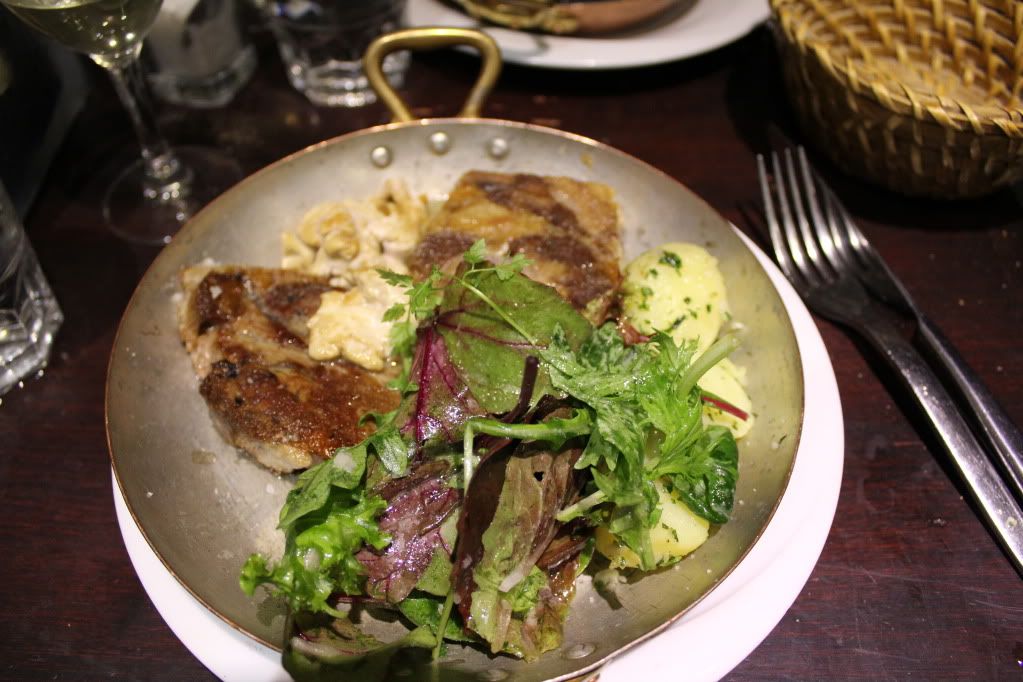
Equal parts tongue, brains, and head. Each with a crispy exterior and moist interior. Served with a delicious gribiche - hard boiled egg vinaigrette. I believe a traditional gribiche is actually mayonaissey, but I loved this vinegary version. One of the most memorable dishes from the trip.
Cheese
No idea it's origins, but it was stinky, slightly soft, and creamy. Loved it.
Ile Flottante - Floating Island
Sweet, but very good. First time I've had this dessert, but would definitely have it at Cafe Constant again.
I was very impressed with the food at Cafe Constant and enjoyed the casual atmosphere and convenient location. Hopefully will get to go back in a few years.
-
-
Post #76 - September 19th, 2012, 12:20 pmMy wife and I differed on our favorite dinner in Paris. She thought that Chez l'Ami Jean was by far our best night out. I enjoyed it immensely, but I think once again, I suffered from high expectations. We had the tasting menu for 8-10 dishes, and while no single dish blew me away, everything was excellent across the board.
I can't seem to find my pictures, so I've forgotten a lot of the meal, which seems to happen to me with tasting menus. However, my single favorite thing I ate that night was the complimentary pate they delivered at the beginning. This was more in the style of a terrine (or cold meatloaf) than the pate I'm used to, but it was incredible. I only wish I would have eaten more - I held back because I knew we were in for a large meal.
They recently changed the menu to only one large tasting menu (they apparently used to have 3 different sized options) or minimal ala carte options. I think I would stick with ala carte ordering if I returned to have more control of what dishes I received. There were quite a few people around us not doing the tasting, and some of the house favorites looked excellent. Plus, I could happily gorge on a ton of that pate.
-
-
Post #77 - September 19th, 2012, 5:24 pmOur only return visit from our honeymoon trip to Paris was a small bistro off the Champs Elysees called Le Hide. It was our last night and we were looking for something near our hotel and reasonably priced. It was a toss-up between Le Hide and L'Entrecote, and I decided I wanted more than one option, so Le Hide it was.
Le Hide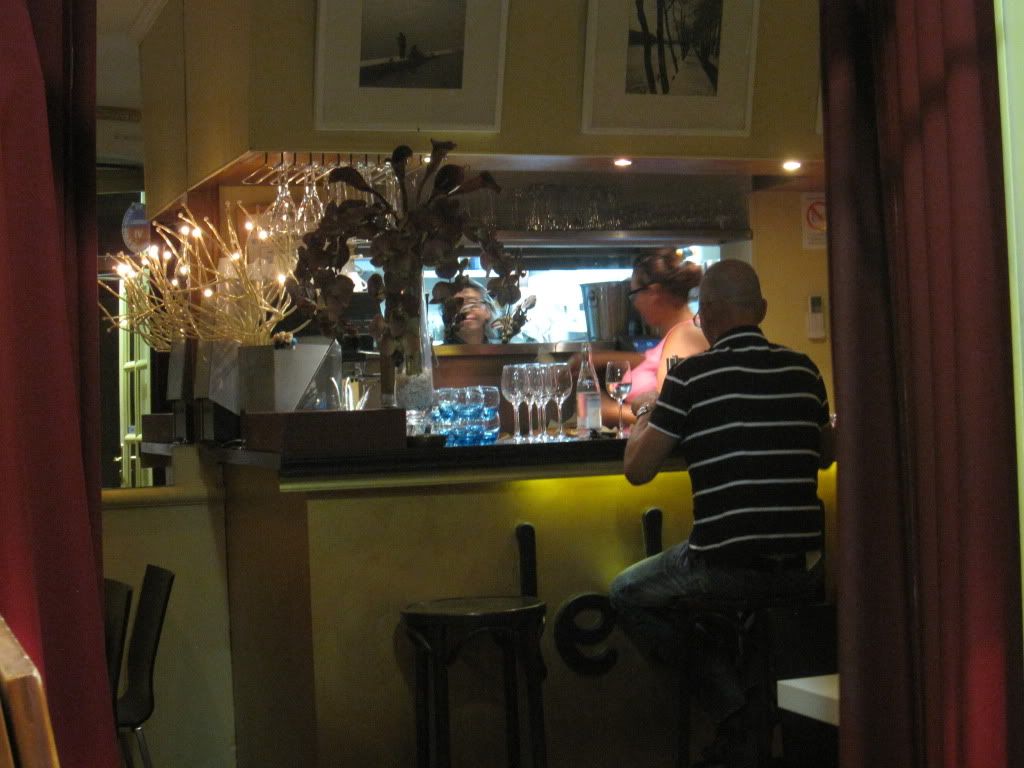
You can see the long-haired Asian executive chef behind the flowers.
Shrimp & Crayfish Ravioli
I liked this a lot - the sauce was delicious.
Crab Stuffed "Crepe"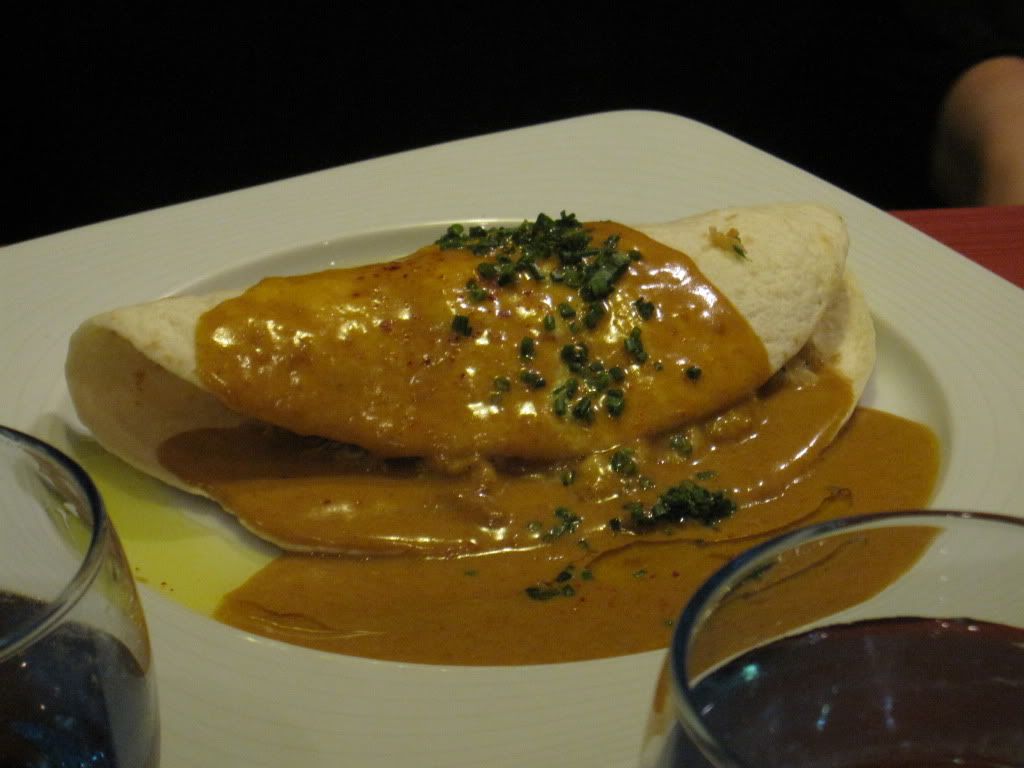
The quotes were on the menu, and we learned why when we were served the plate. The shrimp were stuffed in a crappy flour tortilla. I think this was the chef trying to be playful and failing. It would have been great had it been a real crepe. The sauce and stuffing were excellent. Ended up eating around the tortilla.
Scallops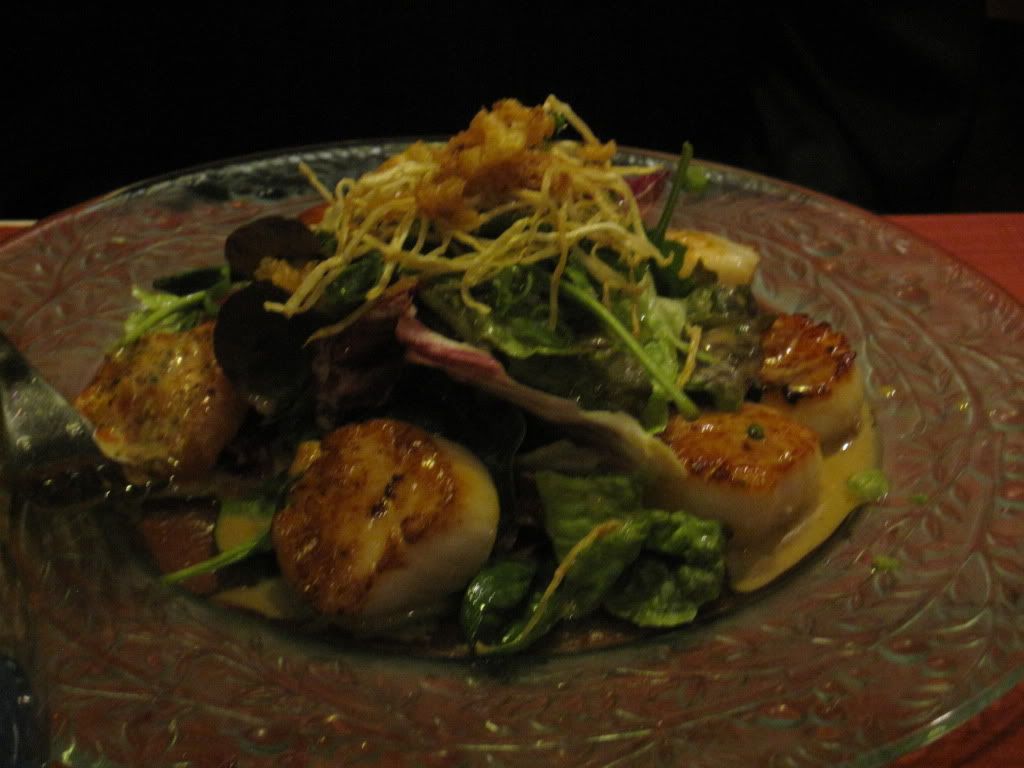
Don't remember trying them but my wife liked them.
Lamb Chops with Mashed Sweet Potatoes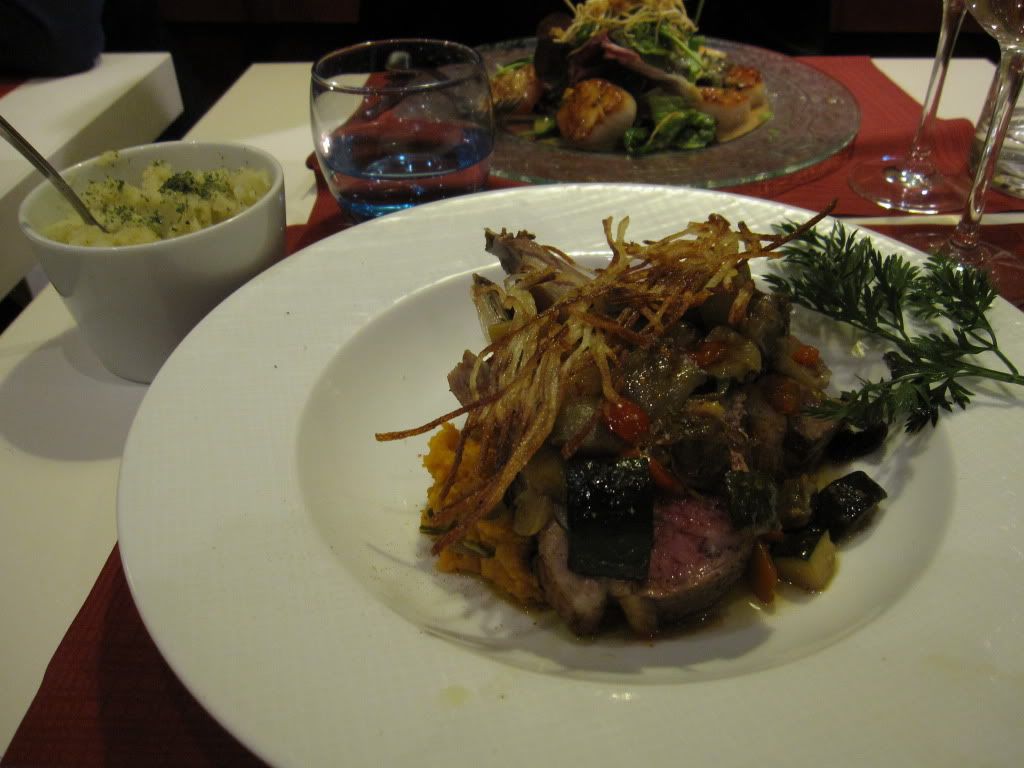
Perfectly cooked, and I liked everything on the plate.
Le Hide is a good option if near the Champs Elysees area and looking for a decent meal, but it's not destination dining. It was reasonably priced. We each had two glasses of wine and our bill came to $95. Besides the errant tortilla, it was a very nice dinner.
-
-
Post #78 - March 31st, 2013, 6:53 pmI'm going to be in Paris for six nights in May before heading down to the Dordogne for the trip I've been planning but putting off for two years now... I'm adding a bunch of these suggestions to a Google Map so I can reference it on the ground. I'm travelling alone, and will be doing a lot of Bistro style eating (plus lots of crepes and croques monsieur from street vendors, assuming they still do that sort of thing). I'll be staying near Place de Clichy, on the edges of Montmartre.
EDIT: Almost all the recommendations are on the Left Bank, oddly... If anyone has some for the Right Bank (especially Montmartre) that would be cool...
-
-
Post #79 - June 4th, 2013, 7:53 amReturned from a trip to France a few weeks ago. Having been to Paris twice before and taken care of the "must sees", it was nice to just relax and focus on good food and wine and just let the city wash over us. A few of the highlights:
I knew exactly where I wanted to go for my first meal. So we dumped our bags at the hotel, walked through the Tuileries then along the quai of the Seine, past Notre Dame and voila, lunch at the Brasserie de l'Isle Saint-Louis, now I know I'm in Paris! The food won't shock and awe you, but it's better than it needs to be given that it's perfectly located at the bridge that connects the Ile de la Cite and the Ile de Saint-Louis. Some of the friendliest waiters in Paris, and a great view of the rear of Notre Dame from the outdoor terrace:
Solid Alsatian food, starting with a bottle of reisling and leeks vinaigrette (poireaux frais vinaigrette).
Main course of steak tartare and choucroute garni:
And for dessert, we grabbed a couple ice cream cones from Berthillon which is just a few steps down the street. My wife polished off her mocha before I could take a picture, luckily she left my wild strawberry alone:
Lunch next day was at Le Comptoir by L'Odeon in St. Germain. I think it's been open about 5 years now, but it's still packing them in. No reservations, we arrived at 1:30pm on a Saturday and there was a 15 minute queue still. Given the incomparable people watching in Paris, there's certainly worse ways to pass some time:
This place has been heavily publicized ever since it opened so I was a little leery that they'd be coasting, especially since the clientele seemed at least 50% tourists. But we both ordered from the seasonal specials, and everything was just fantastic. Always nice when something exceeds expectations. Started with a rose' Bagnols and asparagus:
I had "black footed pork with seasonal vegetables", not sure if the black footed meant Iberico pigs but this was absolutely delicious. Thin cut pork is buried under the excellent vegetables, served with a jus of molten pork fat. Mon Dieu!
My wife is still raving about her vegetable salad weeks later, the fresh fava beans were amazing:
And of course no meal is complete without the cheese course:
We stayed at the Park Hyatt just north of the Place Vendome, tres belle! They had a nice outdoor atrium lobby, nice relaxing spot to chill over an aperitif while reviewing the day and making plans for dinner:
And speaking of dinner...Sunday night is a tough night to find a restaurant that's open. We asked our concierge for something within walking distance, serving classic dishes, not too formal. He made us a reservation at the Restaurant le Royal Madeleine, maybe a ten minute walk from the hotel. Good call Gil! We loved this place, started with white asparagus with hollandaisse:
Then a salad of warm lentilles du Puy in a vinaigrette with crunchy lardons and fresh lettuce, this was amazing:
Following by a classic blanquette de veau. I love the name of this dish, very descriptive. Basically veal cooked and blanketed in it's mother's milk/cream accompanied by carrots, potatoes and mushrooms. Just absolutely delicious, sopped up every last drop of the copious amounts of sauce with two baskets of bread:
So after three nights in Paris, it was off to Le Gare de Lyon to catch the TGV for Burgundy. And the Gare de Lyon just happens to be home of one of the classic belle epoque rooms remaining in Paris, the restaurant Le Train Bleu. Food was just ok, but certainly a pleasant place for lunch while waiting for your train to depart:
So au revoir Paris, and on to Bourgogne...
-
-
Post #80 - June 4th, 2013, 8:31 amLovely Eddie! Man, did you bring back memories! Somehow I knew that your Alsatian lunch would end up with a stroll down the main drag towards the ice creame shoppe! Bien fait!
I hope you're going to stay in Beaune--it's a *great* farm town, whose farmers just happen to make some of the finest wines in the world. Keep your reports coming!
GeoSooo, you like wine and are looking for something good to read? Maybe *this* will do the trick!
-
-
Post #81 - June 4th, 2013, 10:05 amFast Eddie- Good call on the Brasserie de l'lle Saint Louis. Been there about 5 times over a four decades and it's been a first stop for me in Paris as well. I agree that the food is "better than it needs to be!" And somehow, it captures what a visitor to Paris needs to take in. It makes for a good segue into a bateau mouche tour on a jet-lagged first day there.Man : I can't understand how a poet like you can eat that stuff.
T. S. Eliot: Ah, but you're not a poet.
-
-
Post #82 - June 4th, 2013, 10:51 amJosephine & Eddie--I agree totally about Brasserie de l'Isle St-Louis. I lived here for nearly a year, and was a frequent customer. I think their choucroute garnie is among the best in the city. You know you're an LTHer when, independently, you hone in with other LTHers on a particular brasserie in Paris!!

GeoSooo, you like wine and are looking for something good to read? Maybe *this* will do the trick!
-
-
Post #83 - June 4th, 2013, 1:43 pmI was in paris last week. Any Christen Constant restaurant will not disappoint, he has three in the 7th.
-
-
Post #84 - June 5th, 2013, 4:07 amGeo wrote:Josephine & Eddie--I agree totally about Brasserie de l'Isle St-Louis. I lived here for nearly a year, and was a frequent customer. I think their choucroute garnie is among the best in the city. You know you're an LTHer when, independently, you hone in with other LTHers on a particular brasserie in Paris!!

Geo
Exactement! Certain places just seem to capture the essence of a city, for me this brasserie tells me I'm in Paris and I feel grounded and very, very happy.
A few others around the world come to mind that evoke a similar emotion. L'Express in Montreal, Galatoire's in New Orleans, Tia Sophia in Santa Fe, Nuevo León in Chicago, Jack Fry's in Louisville - just off the top of my head of places i have to go to when I revisit.
-
-
Post #85 - January 17th, 2014, 8:52 amI thought I would bump this as I will be traveling to Paris in the future and appreciate any additional input.
Interestingly enough, tired and starving on a day trip from London to Paris we stumbled into the Brasserie de l'Isle St-Louis on a summer day. Sat outside and had a great lunch. I did not remember the name, just the setting. Thanks to Google's Street View, I just realized today that this was where we had lunch in Paris.
-
-
Post #86 - October 22nd, 2015, 11:49 amNot yet home for 24 hours, but I wanted to add a few notes on some of the places we visited in the course of the past week. Most substantial posts to follow (with pics) for most of them. In the meantime…
Lunches:
1. Les Bouquinistes – probably the single best meal I had all week. Absolutely extraordinary. The recommendation for it came from a bookseller across the street who specializes in “foodie” books. It has some relationship with Guy Savoy that I can’t quite understand but this place was affordable and absolutely extraordinary.
2. Terroir Parisien – our first meal in Paris and truly noteworthy. It’s a restaurant of Yannick Alleno and were it not for our arrival at precisely noon, I doubt we would ever have gotten in the door. They save seats at the bar for those arriving without reservations. Amazing lunch.
3. Le Comptoir du Relais – tiny, classic. Again, we arrived at precisely the right moment and squeezed in around 1:30 pm. Wonderful classic brasserie. I’ve seen commentary that it’s largely patronized by tourists. But given the fact that we were almost completely surrounded by Parisians, I’m not so sure. And, in the end, who cares? The food was lovely.
4. Waknine – A little off the beaten track (near the Trocadero in the 16th). Extremely popular lunch place; cozy, comfortable, and with top-notch food. We got there at the stroke of noon and as we were debating, a guy walks out and says, with an American accent, that the food is terrific. Boy, was he right! One of the few times we felt like we were REALLY in Paris. Despite the English menu (hilariously translated in a few cases), we were the only English speakers in the house and enjoyed our lunch immensely.
Dinners:
1. La Regalade-Saint Honore – Our server (who spoke almost no English) made life a delight (she chose an absolutely amazing wine for me) and the kitchen made this a really memorable meal. Best dinner in Paris.
2. Chez Dumonet – Maybe if chef had left the kitchen (assuming he was even there), our experience would have been better. But although the food was extraordinary, service suffered from the fact that this place was jam-packed to bursting on a Tuesday. We considered ourselves fortunate to be served each course in a timely manner. Such a pity because it could have been a nearly perfect evening and wasn’t. No one’s fault and the small staff did the best they could but the place couldn’t have been busier.
3. Bistrot Paul Bert – my fault, I guess, for choosing the wrong thing. One of the blandest plates I’ve had in a long, long time (brill with white beans), putting a nice squid salad opener in the shade. The seasoning was mostly MIA, both on the fish and in the beans. Dessert a surprisingly less than impressive tarte tatin. Sad. Clearly a classic of a place and I suspect a different order on a different night might have made all the difference in the world.
4. Brasserie de L’Isle Saint Louis – yikes! The most awe-inspiring choucroute garnie I’ve ever had, or could ever hope to have. Pounds of meats. Absolutely amazing place. Old school, jammed with tourists and locals alike. A real character of a waiter who, though speaking minimal English managed to entertain us and provide positively lovely service. A memorable evening.
Patisseries:
We went most of the places we are/were supposed to visit and had something at every one of them. I shudder to think of the amount of butter I ingested in the past week. Still, despite some terrific stuff (and a few clunkers), I’ll limit my comments/recommendation to two places.
The first, we were fortunate to have it a block from our hotel in the 5th. If you are in the vicinity and don’t visit, you’re making a life mistake. I simply cannot imagine a more perfect croissant. Sebastien Degardin. (Among other things, he worked at Troisgros from 1996 to 2004, where he was the youngest pastry chef of any three-star restaurant in the country, at 25.) Not everything there was the platonic ideal (I didn’t care for the almond croissant, actually), but the overall level of pastries was extraordinary. Do-Not-Miss.
The second we discovered walking around before dinner in the neighborhood of La Regalade: La Bague de Kenza. Algerian pastries. We didn't have much time to chat, which I regret now because we bought a bunch of small things and snarfed away at them the next day. Wonderful stuff. Well worth a repeat visit.
Most of the places I mentioned have already had address info posted, but I’all add the info on the new ones I’ve mentioned.
LES BOUQUINISTES, Restaurant avec [whatever that means—yes, I know it means “with”] Guy Savoy
53, quai des Grands Augustins, 75006 Paris
Tel: 01 43 25 45 94
http://www.lesbouquinistes.com/
TERROIR PARISIEN
20, rue Saint Victor, 75005 Paris
Tel: 01 44 31 54 54
http://www.yannick-alleno.com/carnet/terroir-parisien/
LE COMPTOIR DU RELAIS
9, carrefour de l’Odéon, 75006 Paris
Tel: 01 44 27 07 97
No website (but affiliated with the hotel next door, Hotel Relais St. Germain whose website can be found at http://www.hotel-paris-relais-saint-germain.com/ You can see the awning for the restaurant in their picture; it's literally next door). You can find a video for the Comptoir on their site; unhelpful, but it will give you a good idea of just how tiny this place is.
WAKNINE
9, Avenue Pierre 1er de Serbie, 75116 Paris
Tel: 01 47 23 48 18
http://www.waknine.fr
SÉBASTIEN DÉGARDIN a/k/a PATISSERIE DU PANTHEON
200, rue Saint-Jacques - 75005 Paris
Tel: 01 43 07 77 59
http://www.sebastien-degardin.com/
LA BAGUE DE KENZA
136, rue St Honore, 75001 Paris
Tel: 01 42 86 85 23
http://www.labaguedekenza.com/Gypsy Boy
"I am not a glutton--I am an explorer of food." (Erma Bombeck)
-
-
Post #87 - October 24th, 2015, 9:08 amLa Brasserie de L'Isle Saint Louis: thanks, Fast Eddie!
There isn't a whole lot of commentary I can add to what Fast Eddie and others have said about this place except to affirm their praises. As you can see from both the menu and the single interior shot, it's Paris. There may be tourists but there are also Parisians and the place fairly reeks of old-time Paris, right down to the servers. We had a real character serving us (you can see him in profile, with his black vest, next to the desk); his English was minimal and my French is okay, but I am certain that even if I had not spoken a word of French, we would have gotten along famously.
Interior
What did I tell you? You can almost smell the atmosphere!
Menu
Classics. Extremely reasonable prices. (As of the time of this post, you can add about 10% and get the prices in dollars.)
Gendarme fumé
Gendarme, as in cop; fumé, as in smoked. The "smoked" part is clear; the reference to the "cop" less so. The sausage is so named, in my understanding, because of its resemblance to the French cop's stick or baton. Hard sausage, slightly spicy, heavily smoked--lovely with the gherkins and pickled onions. And the beer. The only disappointment was the beer selection which was disappointingly tiny.
Dos de cabillaud doré (back of cod, basil sauce)
On a bed of spinach, even the Lovely Dining Companion--who is not a particular fan of fish--loved this presentation. Flavorful, tasty, and plenty to eat. Indeed, she commented, quite rightly, on how full of flavor the potatoes were. Too often, here, potatoes are an obligatory side and taste of nothing so much as whatever you put on them...butter, sour cream.... It's such a pleasure to eat potatoes that actually have flavor and nuance to them.
Choucroute garnie
Waddling doesn't even begin to describe the pace and style of my walking after this. Admittedly, I didn't quite finish, though I do think I managed to shovel down about 95% of it. The veal sausage was particularly noteworthy and the blood sausage also quite nice. The only difficulty is the three pounds (or more) of meat!
Tarte tatin and creme fraiche
I had to. I just had to. But for the first time in living memory, I left a bite on my plate.
If you go to Paris, you really should drop by. They don't take reservations, though, so get there early. It's about as central a location as you'll find, and sadly, places like this are disappearing all too quickly. You won't find many like it and while the food may not be five star, I can guarantee you'll enjoy your meal and, even better, the entire experience.
La Brasserie de L'Isle Saint Louis
55, quai de Bourbon 75004 Paris
Tél: 01 43 54 02 59
Open continuously from noon to 11 pm
(Closed Wednesdays)
http://www.labrasserie-isl.fr/infos.htmGypsy Boy
"I am not a glutton--I am an explorer of food." (Erma Bombeck)
-
-
Post #88 - October 26th, 2015, 8:57 amDe rien Gitane, glad you liked it. I've usually eaten outdoors for the people watching, but I ate inside in January once - the interior is great, and that menu is perfect for cold weather eating. Nothing like tucking into a big steamy choucroute garnie on an autumn or winter day.
If remembering the meal is the mark of a good restaurant than this place definitely fits the bill. That January day I had a coq au Riesling (your basic coq au vin, but with white wine instead of red) and an incredibly funky, runny, deliciously nasty piece of Munster cheese afterwards. I'm salivating just thinking about it, good stuff!
-
-
Post #89 - October 26th, 2015, 1:04 pmEddie,
I lived for almost a year about 150m from that restaurant. Went once a month, just to pork out on the choucroute garni. Yum! Awful nice place, really Parisian, even with the odd tourist or so involved. So glad to hear it still delivers.
GeoSooo, you like wine and are looking for something good to read? Maybe *this* will do the trick!
-
-
Post #90 - October 26th, 2015, 5:04 pmGeo, Eddie, and Gypsy Boy
You guys made me painfully nostalgic with your stories about the Brasserie de l'Isle Saint Louis.
Me too I used to live 120 meters from it across the Seine and for a long time was a regular at this marvelous place.
Allow me to share a few memories based on memories and impressions I had following a great lunch there 2 years ago that i posted on my blog French virtual Cafe, here it is.
La Brasserie de l’Isle Saint-Louis
6 weeks ago, the weather was rather grey, humid, really gloomy. On November 13, around 1:00 PM, I had a sudden craving for a good choucroute garnie to lift my spirits. But since my favorite place L’Alsaco now longer exists, I did not know where to go to find a decent one. In the past 20 years I have been disappointed so many times by the choucroute at Chez Jenny, Place de la République, or at Chez Flo, Passage des Petites Ecuries, that I did not want to get back there.
Suddenly I remembered that last February I had read a piece in the excellent and always reliable ‘’Hungry For Paris’’ blog of Alexander Lobrano about this good old Alsatian brasserie located at the end of the delightful Ile Saint Louis at 55 Quai de Bourbon in the 4th. Lots of warm memories about this place immediately came back to my mind. In the very early 60s, when I was a student at La Sorbonne, I did not have much money but I was lucky to live in a comfortable room in the apartment of a friend who lived at 11 Quai aux Fleurs, in the Ile de la Cité, just behind Notre Dame. My bedroom windows were facing the mansion of the Aga Khan and the Seine river. And just a few yards from there, there was a little ‘’passerelle’’, a mini bridge of sort, that crossed the Seine into the Ile Saint Louis. At the end of this bridge was La Brasserie de l’Isle Saint Louis, which in those days did not have the charming “terrasse” it has now.
At the time, it did not take me long to discover that I could have a pair of juicy frankfurters with a boiled potato and fragrant warm sauerkraut for a few francs if I ate ‘’au comptoir’’ in the mini bar area at the entrance of the restaurant. There was an Impressive old shiny metal percolateur (an ancestor of the coffee machine) at the end of the massive wood comptoir (bar counter, perhaps covered with Zinc or copper, I do not remember exactly), that is still there. By the way, if my memory is correct, the percolateur that was installed on the bar in 1913 when the restaurant was known as La Taverne du Pont Rouge, was still able to produce a strong coffee in 1959, the first time I went there when I was spending a week at the home of a couple, friends of my parents, who lived in Paris. The waiters in traditional ‘’serveurs’’ outfits including white shirts, black bow ties, black pants, black vest, and a white apron, would come to the bar to get their orders of draft beer, an excellent and foamy Mutzig from Alsace served in half-liter stoneware (grès) steins, called ‘’pots’’, and get their food orders from the kitchen through a hole in a door at the end of the bar. Sometimes the chef, a tall blond German guy name Otto, would exit the kitchen and sit a moment at the bar to drink a beer and smoke a cigarette. He would fix for me marvelous omelettes baveuses au lard (runny omelets with lardons). One of the most active and funny waiters was named Yvan, and he was always joking and making funny comments to attract the attention of the many American young ladies who visited the restaurant. He called his regular customers, including me, ‘’l’ami’’ (the friend). But he could get moody sometimes when things did not go the way he wanted.
There were a couple of tables in the bar, and many times when the place was packed, which has been the case since it opened, I would sit there and have quick lunch before going back home to study, usually a potato salad with a knackwurst, a piece of cheese and a stein of beer.
Everything seemed the same when I entered the restaurant last month. The ambiance with a blend of reserved traditional older Parisian customers discussing family matters or real estate deals in a soft voice, much noisier and lively out-of-town visitors, including a few American and German tourists, and some young couples, was about the same as 50 years ago. The smells reflecting the good hearty food that is slowly cooked in the kitchen every day, was the same. The photos and posters on the walls, the collections of ancient beer mugs and steins, the hunting artifacts, the arrangement of the wooden tables with their checkered red and white cloth were still there. But a few things were different: The stuffed stork is now at the back of the restaurant, there is no longer the smoke of the cigarettes and cigar permeating everything, and I could not recognize more than one waiter. Besides, I did not know the dapper young man who was standing in front of the old wooden desk near the entrance which is the command center and the billing and cash registering station of the operation. In the early days, it was Monsieur Paul, the owner, or is wife, who were sitting there.
Fortunately the waiter who was assigned to my table just behind the bar, the only one I had recognized, had been working there for more than 20 years, and he was gracious enough, besides providing good old service, to answer my questions. Unfortunately he told me than Yvan, who had been fighting in the Algerian war, and had health problems since, had passed away. Otto, who had been a cook for Marshall Rommel during the Tunisian campaign in 42-43, and had acquired the French nationality after the war, had also passed away.
The elegant young man, Paul-Emmanuel was obviously managing the restaurant the day I was there. He is one of the 2 sons of Marcel and Michèle Kappe the owners of the restaurant since the father of Madame Kappe, Paul Guépratte, whom we used to call Monsieur Paul, as I just said, when I was a regular there in the early sixties retired.
Paul Guépratte, the young man’s grand-father, purchased the restaurant in December of 1953, at the time it was called L’Oasis, from an another Alsatian man, Monsieur Lauer. Guépratte had an apartment nearby that he used when he was in Paris. This is how he learned about Lauer’s intention to sell his restaurant. As it was customary at the time, the deal was made with a handshake at the bar. Paul Guépratte, and his wife Marthe, who was often standing behind the front desk preparing checks and greeting customers, gave the restaurant its present name.
After I finished my meal I asked Paul Emmanuel Kappe a few questions and congratulated him on the quality of the choucroute garnie I had just finished. I told him that it was even better that I remembered it. I asked him if they still bought their meats from Schmid, a well-known Parisian supplier of Alsatian charcuterie, but his answer was that they had after many years changed suppliers. I believe the new one is Jund. He told me that they still cooked themselves their choucroute every day, and that they might be the last brasserie in Paris to do so. In fact all their hot dishes are home-prepared and cooked according to the old traditions of their brasserie.
Same for the excellent Mutzig beer, and their Munster fermier au cumin (a delicious creamy and slightly pungent Alsatian cheese served with caraway seeds),which are both as good as ever.
They still serve the delicious sorbets from Berthillon, an internationally famous family-owned maker of ice cream and fruits sorbets established in1954 and located a couple of blocks away.
When I discovered the place in 1963, they were still I believe selling charcoal bags in the store.
The choucroute garnie I ate in November was one of the best I had in years. It is served on a pretty porcelain plate engraved with the name of the brasserie. The white cabbage was cooked to perfection, aromatic with just the needed touch of acidity. It was at the same time moist and still a bit crisp. There were plenty of juniper berries and enough peppercorn left in the cabbage.
Now, the best part was the incredible quality of the generous sample of pork and charcuterie. I will try to remember its components but my memory is sometimes unfaithful.
One link of deliciously aromatic boudin noir (blood sausage). One link of very delicate white sausage, perhaps veal and pork based, that seemed to be flavored with small fragments of truffle. One piece of palette (lean part of the pork shoulder). One piece of pork knuckle. One frankfurter sausage. One slice of lard de poitrine (thick bacon). One piece of knackwurst. One slice of garlic sausage. And pehaps one slice of Jambon de Paris (white ham), but I am not certain about this last component.
As I said, the artisan Munster cheese was very good with its cumin (caraway) seeds on the side, and so was the sorbet.
I limited myself to one stein of beer.
Too bad the weather was not more pleasant since I would have finished that meal sitting outside on the beautiful terrace, facing Notre-Dame cathedral, drinking a cup of their excellent espresso with a tiny glass of kirshwasser.
Maybe next time since this experience was so pleasant that I cannot wait to return.

